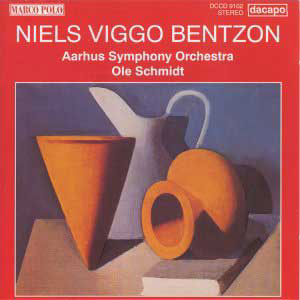Bentzon's prolifically creative drive is evidenced
by more than twenty symphonies, fifteen piano concertos, four violin
concertos, three cello concertos, countless sonatas, quartets, suites;
not to mention the oratorio Torquilla (not something I have yet
heard) and the grandly conceived and executed piano structure Det
Tempererede Klaver.
The Third and Fourth symphonies commanded airtime on
the BBC Third Programme in the 1950s, no doubt under the benevolence
and acute judgement of Robert Layton and Robert Simpson. They were taken
up by BBC Radio 3 again in the early 1980s when Ole Schmidt was
more of a presence than he is now. Remember that he also conducted the
1980 revival at the Royal Albert Hall of Havergal Brian's Gothic
Symphony.
As Anker Blyme's notes say, the Third Symphony uses
a language that is clear and straightforward, accessible in a genuine
and inviting manner. The derivation is clearly from Nielsen both in
the pounding rhythmic material and in the sunlit glow (Helios).
Bentzon's jumping-off point is more closely related to the Espansiva
than to the enigmatic Sixth Symphony. There is a saxophone in the andante.
The finale has a rasping, rippling, strenuously heroic quality again
with some decidedly Nielsen-like twists and turns - though fewer than
you might expect. There is about the finale something of Hindemith's
symphonic manner as in Harmonie der Welt. Just the next year
came the Fourth Symphony. This is in three movements played without
pause but separately tracked here. Influences include Kodaly's Hary
Janos and Shostakovich (I, 10.13; II 6.48). Bentzon now makes more
use of solo instrumental colour. This is a more transparently orchestrated
work than its suave grand-toned predecessor. The writing has the fantastical
character of a 'concerto for orchestra'. In the Tempo di largamente
middle movement the harp conjures raptly glistening textures in
a way totally liberated from anything Nielsen ever wrote. There is something
delicately balletic about this writing and this carries over into the
Allegro ma non troppo which ends in triumphantly confident understatement.
Surely the time has come for a complete cycle of the
Bentzon symphonies. Who will be the first to embark on this Odyssey?
While we wait, do snap up this disc and the other Dacapo which couples
symphonies 5 and 7 (8.224111).
These are two significant symphonies - one in transition;
the other in which Bentzon's originality and invention is fully developed
and asserted.
Rob Barnett


